Experiencing Wind Farms In The Landscape
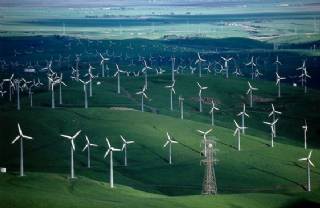
People’s responses to wind farms vary –to some a wind farm may seem to dominate its surroundings, while others may view it as an exciting, modern addition with symbolic associations with clean energy and sustainability. Our understanding of people’s responses to wind farm development is informed by a number of public attitude studies. UK-wide research has shown that two thirds of adults are in favour of wind power.
The impact of a wind farm will depend on how,and from where,it is experienced; for example, from inside a residence, while moving along a road, or from a remote mountaintop. These factors are taken into account through LVIA when determining the sensitivity of the landscape and visual resource, and the people that will be affected by the development (receptors). LVIA includes assessment of impacts upon the key users of the landscape, including residents, motorists, workers,those partaking in recreation and tourists.
A wind farm’s impacts on local residents requires particular attention as, unlike visitors, they will experience a wind farm from different locations, at different times of the day, usually for longer periods of time, and in different seasons. Conversely, impacts on tourists and those taking part in recreation may be relatively brief, but their sensitivity to landscape change is regarded as high because their purpose is often to enjoy their surroundings.
It is important to take account of how a wind farm will be experienced from surrounding roads, transport, and recreational routes. Views will vary depending on proximity to the road, the mode of transport, the angle of view, and intervening landscape features. The first glimpse of a wind farm
is important, and careful consideration should be given to the design of the wind farm layout in relation to these views.
As larger numbers of wind farms are built it has become increasingly important to consider their cumulative effects and the context in which they are seen. Of particular importance are: how developments relate to each other in design and relationship to their settings; their frequency as one moves through the landscape; and their visual separation to allow experience of the character of the landscape in-between. Further detail on this aspect of LVIA can be found inour‘Cumulative Effect of Wind Farms’guidance.
The visibility and visual impacts of a wind farmare affected by the distance from which it is viewed, as well as other aspects such as weather conditions,siting and its context. In the past, several guidance notes offered generic categories of degrees of visibility and visual impact related to distance. This is no longer considered helpful as there is now such variation in turbine size and design. Wind turbines of between 100 –150m can be visible at distances of up to 40 or 50km in some conditions; whilst single turbines of up to 50m are only visible at smaller distances. The LVIA needs to assess the likely visibility of an individual application in detail.
Labels
solar wind turbineenvironmental impact of wind energyuses of windmillenvironmental effects of wind energyhow do windmills workwind turbine bladeswind turbine yachtwind turbine portable5 kilowatt wind turbineFarming Principle: Deep Soil Preparation
Looking at GB as a three-legged stool, deep soil preparation is one of the legs. Deep soil preparation builds soil and soil structure by loosening the soil to a depth of 24 inches (60 cm). Ideal soil structure has both pore space for air and water to move freely and soil particles that hold together nicely.

Smart Home Ecosystem - Smart Home Automation - Smart Home Security - Smart Home Technology
The outer-most level corresponds to the individual devices and sensors that consumers interact with. Several candidates are vying for the role of a leader introducing smart home services to the mass market.

Solar Energy Systems - Solar Modules - Solar Electric System Design - Solar Power
The heart of a photovoltaic system is the solar module. Many photovoltaic cells are wired together by the manufacturer to produce a solar module. When installed at a site, solar modules are wired together in series to form strings. Strings of modules are connected in parallel to form an array.
Solar Energy Systems - Array Mounting Racks - Solar Ray - Solar Panel - PV Racks and Mounts
Arrays are most commonly mounted on roofs or on steel poles set in concrete. In certain applications, they may be mounted at ground level or on building walls. Solar modules can also be mounted to serve as part or all of a shade structure such as a patio cover. On roof-mounted systems, the PV array is typically mounted on fixed racks, parallel to t

Solar Energy Systems - Grounding Equipment
Grounding equipment provides a well-defined, low-resistance path from your system to the ground to protect your system from current surges from lightning strikes or equipment malfunctions. Grounding also stabilizes voltages and provides a common reference point. The grounding harness is usually located on the roof.
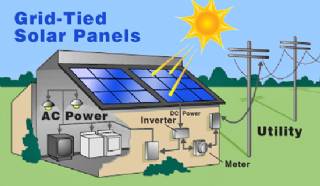
Solar Energy Systems - Solar Inverter - Solar Panel Inverter
Most grid-connected inverters can be installed outdoors, while most off-grid inverters are not weatherproof. There are essentially two types of grid-interactive inverters: those designed for use with batteries and those designed for a system without batteries.
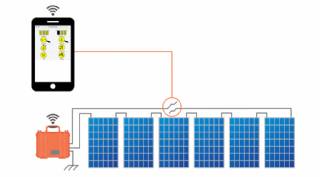
Solar Energy Systems - Solar Disconnects
Automatic and manual safety disconnects protect the wiring and components from power surges and other equipment malfunctions. They also ensure the system can be safely shut down and system components can be removed for maintenance and repair.
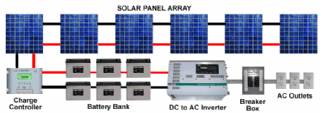
Solar Energy Systems - Solar Battery Bank
Batteries store direct current electrical energy for later use. This energy storage comes at a cost, however, since batteries reduce the efficiency and output of the PV system, typically by about 10 percent for lead-acid batteries. Batteries also increase the complexity and cost of the system.

Solar Energy Systems - Solar Charge Controller
A charge controller, sometimes referred to as a photovoltaic controller or battery charger, is only necessary in systems with battery back-up. The primary function of a charge controller is to prevent overcharging of the batteries. Most also include a lowvoltage disconnect that prevents over-discharging batteries. In addition, charge controllers pr
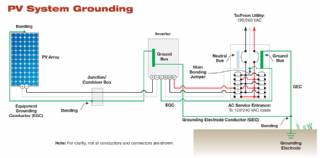
Solar Energy Systems - The NEC and PV Systems
Solar PV systems must be installed in accordance with Article 690 of the National Electric Code, which specifically deals with PV systems, as well as several other articles of the NEC that pertain to electrical systems in general. When there is a conflict between NEC 690 and any other article, NEC 690 takes precedence due to the unique nature of PV